Centaurs
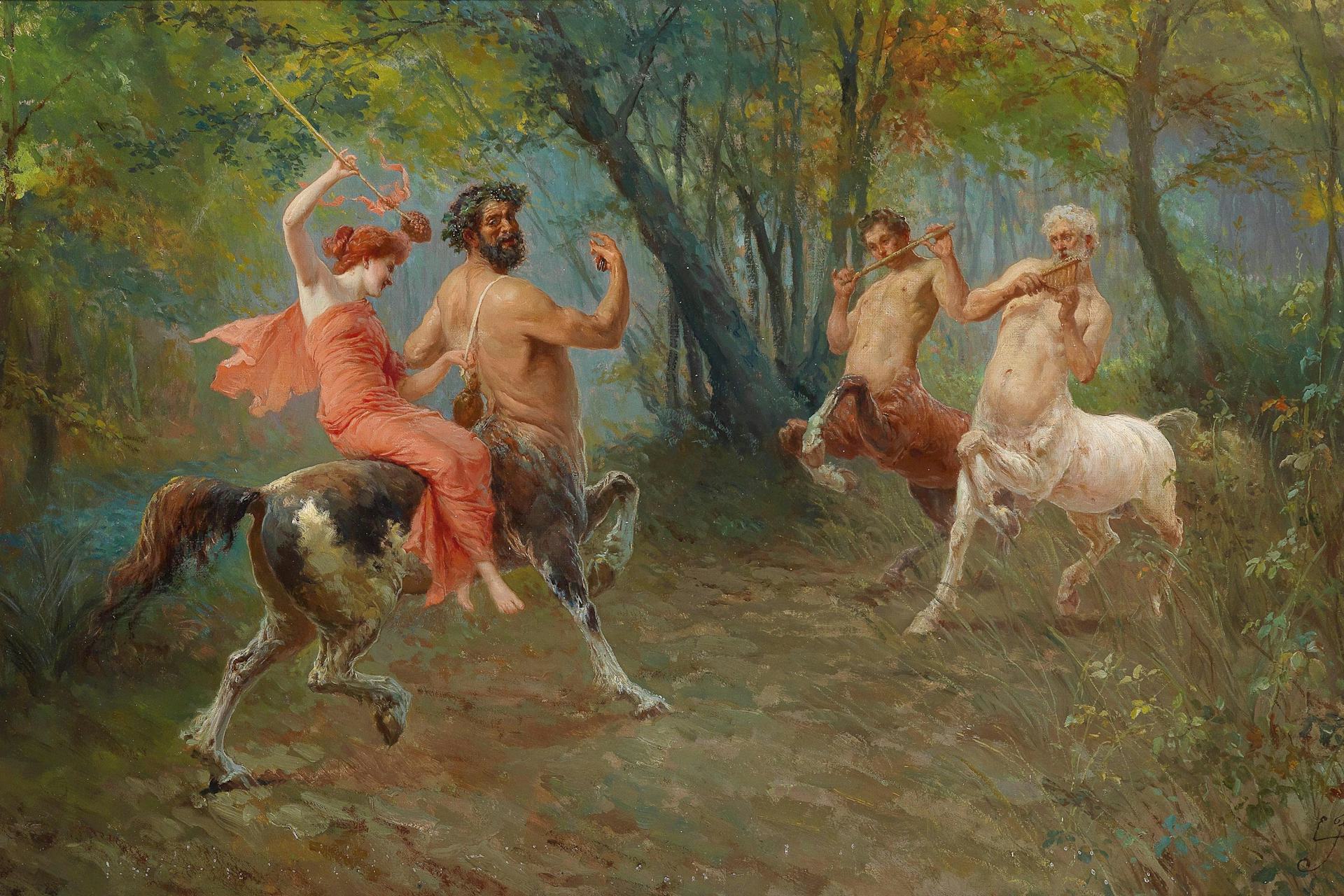
Festival of Centaurs by Ettore Forti (ca. 1880–1920).
Wikimedia CommonsPublic DomainOverview
The Centaurs, occasionally called “Hippocentaurs,” were a race of savage creatures. Though usually represented as the sons or grandsons of a mortal man (King Ixion), they were hybrid beings, featuring the upper body of a human and the lower body and four legs of a horse.
The Centaurs inhabited the mountains of northern Greece, where they challenged (and were defeated by) many famous heroes, including Heracles, Pirithous, and Atalanta. Two of the Centaurs, Pholus and Chiron, were actually friendly to mortals, but they were the exception that proved the rule: for the Greeks, the Centaurs symbolized everything that stood against culture and civilization.
Etymology
There is no agreed-upon etymology for the term “Centaur” (Greek κένταυρος, translit. kéntauros; pl. “Centaurs,” Greek κένταυροι, translit. kéntauroi). It may be connected with the Greek words κεντεῖν (kenteîn, “to pierce, poke”) and αὔρα (aúra, “wind”); if so, “Centaur” would mean something like “Pokewind” (possibly a reference to the myth of the Centaurs’ origins; see below).[1] Ancient folk etymologies sometimes sought a connection between “Centaur” and the Greek word ταῦρος (taûros), meaning “bull.”[2]
Martin Bernal has looked elsewhere for the etymology of the term, suggesting that “Centaur” comes from the ancient Egyptian *kꜣ nṯr, meaning “holy spirit.” The Centaurs’ name could thus be understood as euphemistic, a kind of linguistic attempt to neutralize the creatures’ violent and terrible nature.[3]
Pronunciation
English
Greek
Centaur, Centaurs κένταυρος, κένταυροι (translit. kéntauros, kéntauroi) Phonetic
IPA
[SEN-tawr], [SEN-tawrz] /ˈsɛn tɔr/, /ˈsɛn tɔrz/
Alternate Names and Epithets
Some ancient sources spoke of “Hippocentaurs” (that is, “Horse-Centaurs”).[4] Even in antiquity, it was debated whether “Centaurs” and “Hippocentaurs” referred to the same creatures. In some traditions, the “Centaurs” were human sons of Ixion, while the “Hippocentaurs” were the Centaurs’ half-horse offspring.[5]
Other sources referred to the Centaurs simply as φῆρες (phêres), an Aeolic Greek word meaning “beasts.”[6]
Attributes
Locales
The Greeks usually imagined the Centaurs as living in the wooded mountains of northern Greece, especially Thessaly. The common tradition said that they had originated on Mount Pelion in southeastern Thessaly, near the kingdom of the Lapiths—the Centaurs’ most important enemies.[7]

View of the south of Mount Pelion in northern Greece.
Heidi B.CC BY-SA 3.0In their various battles with the heroes, the Centaurs were gradually pushed further south, establishing communities in parts of the Peloponnese such as the Pholoe Range in Arcadia and Cape Malea.[8] But other traditions said the Centaurs moved west rather than south, to the Pindus Mountains.[9]
Appearance and Abilities
The earliest references to the Centaurs—which come from the Homeric epics—do not say anything about their appearance, though they do label Centaurs as “beasts” and clearly distinguish between Centaurs and humans.[10] It would seem, then, that Centaurs had at least some animal attributes from the very beginning.
In later times, Centaurs were usually represented as having the torso, arms, and head of a human and the body and four legs of a horse. But there were some variations. It is likely that Centaurs were originally human from head to toe but had the trunk and hind legs of a horse growing from their buttocks or lower back (see below). Other sources claimed that there were different kinds of Centaurs, some of whom had horns growing from their otherwise human heads.[11]
Centaurs were originally all male. Female Centaurs, or “Centaurides,” were probably introduced no earlier than the fifth century BCE, and even then, they were regarded as novelties.[12] Female Centaurs did sometimes appear in later art and literature: Ovid, for instance, tells of a female Centaur named Hylonome, whom he may or may not have invented.[13]
Centaurs represented the combination of animal aggression and human intellect—though their aggression always dominated. As a result, the Centaurs were the antithesis of civilization. They ate raw meat,[14] and their defining characteristic was their lust: they were often known to carry off and rape women.
Centaurs were also said to lose control when they drank wine. This suggests a connection between the Centaurs and creatures like silens, who belonged to the entourage of Dionysus, the god of wine and frenzy.[15] But unlike the amusing and fun-loving silens, the Centaurs were thought to pose a real threat to civilization.
It is possible that all Centaurs were originally immortal. Indeed, the earliest reference to the battle between the Centaurs and the Lapith heroes specifies that they were not killed but rather expelled from the land.[16] But in later literature and art, we routinely hear of Centaurs who die or are killed. One Centaur, the wise Chiron—whose parentage was different from that of the other Centaurs—was definitely immortal, though he, too, eventually died.[17]
Iconography
Centaurs are attested in the Greek visual arts from as early as the tenth century BCE. Early depictions generally showed Centaurs as completely human, with the trunk and hind legs of a horse growing out of their back.[18] But by the second half of the seventh century BCE, Centaurs had more or less acquired their familiar form: human from the waist up with the body and four legs of a horse.[19]
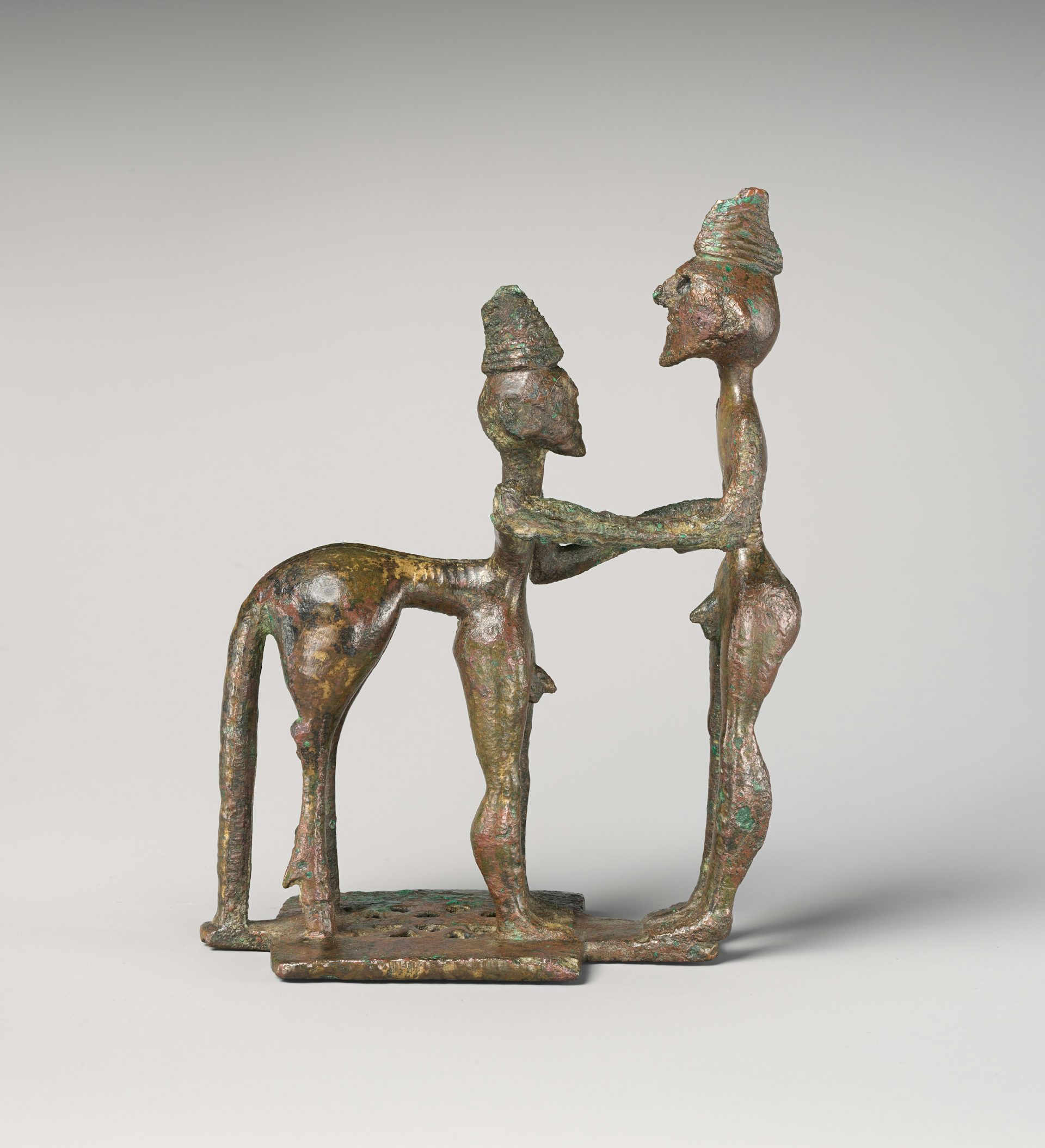
Bronze man and Centaur (mid-8th century BCE). The Centaur is shown with the body of a man and the trunk and two hind legs of a horse growing out of his lower back.
Metropolitan Museum of ArtPublic Domain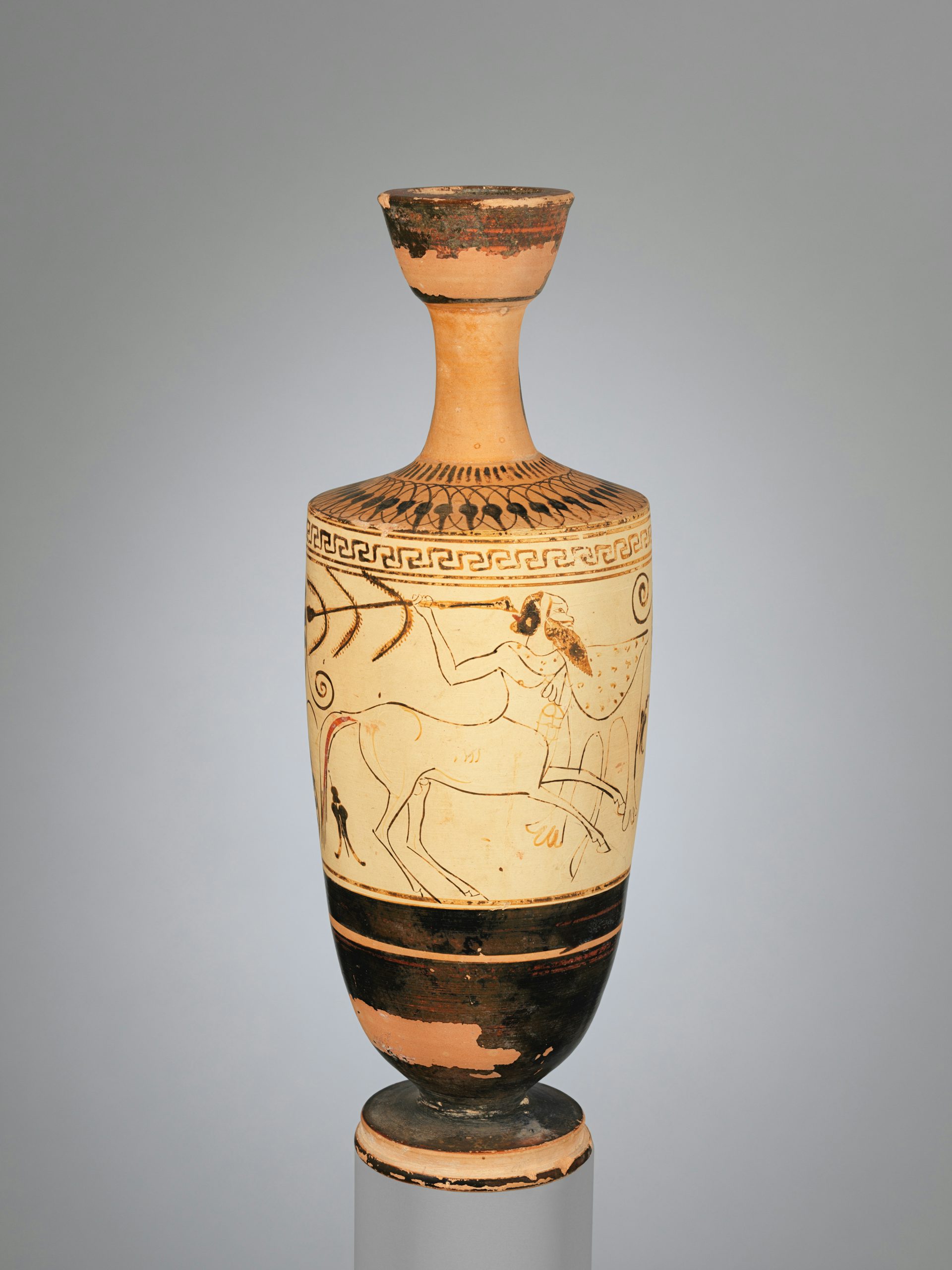
Terracotta lekythos (oil flask) showing a Centaur with the body and four legs of a horse and wielding an uprooted pine tree. Attributed to the workshop of the Diosophos Painter (early 5th century BCE).
Metropolitan Museum of ArtPublic DomainCentaurs were often depicted with attributes that emphasized their savagery, such as long, shaggy hair, an unkempt beard, long horse ears, and a snub nose like a satyr’s. They wielded branches and tree trunks as weapons and sometimes wore fur as protection. In certain contexts, they carried attributes like drinking vessels, musical instruments, and wreaths. This served to further connect them with the god Dionysus and his entourage.
The most popular and widespread Centaur motif in ancient art was the “Centauromachy,” or “Battle of the Centaurs.” Centauromachies showed violent clashes between the Centaurs and heroes like Heracles or the Lapiths. For the Greeks, these scenes represented the neverending war between the forces of order and the forces of chaos. Famous Centauromachies could be seen decorating the Temple of Zeus at Olympia (ca. 460 BCE), the Parthenon in Athens (ca. 447–440 BCE), and the Mausoleum of Halicarnassus (mid-fourth century BCE).
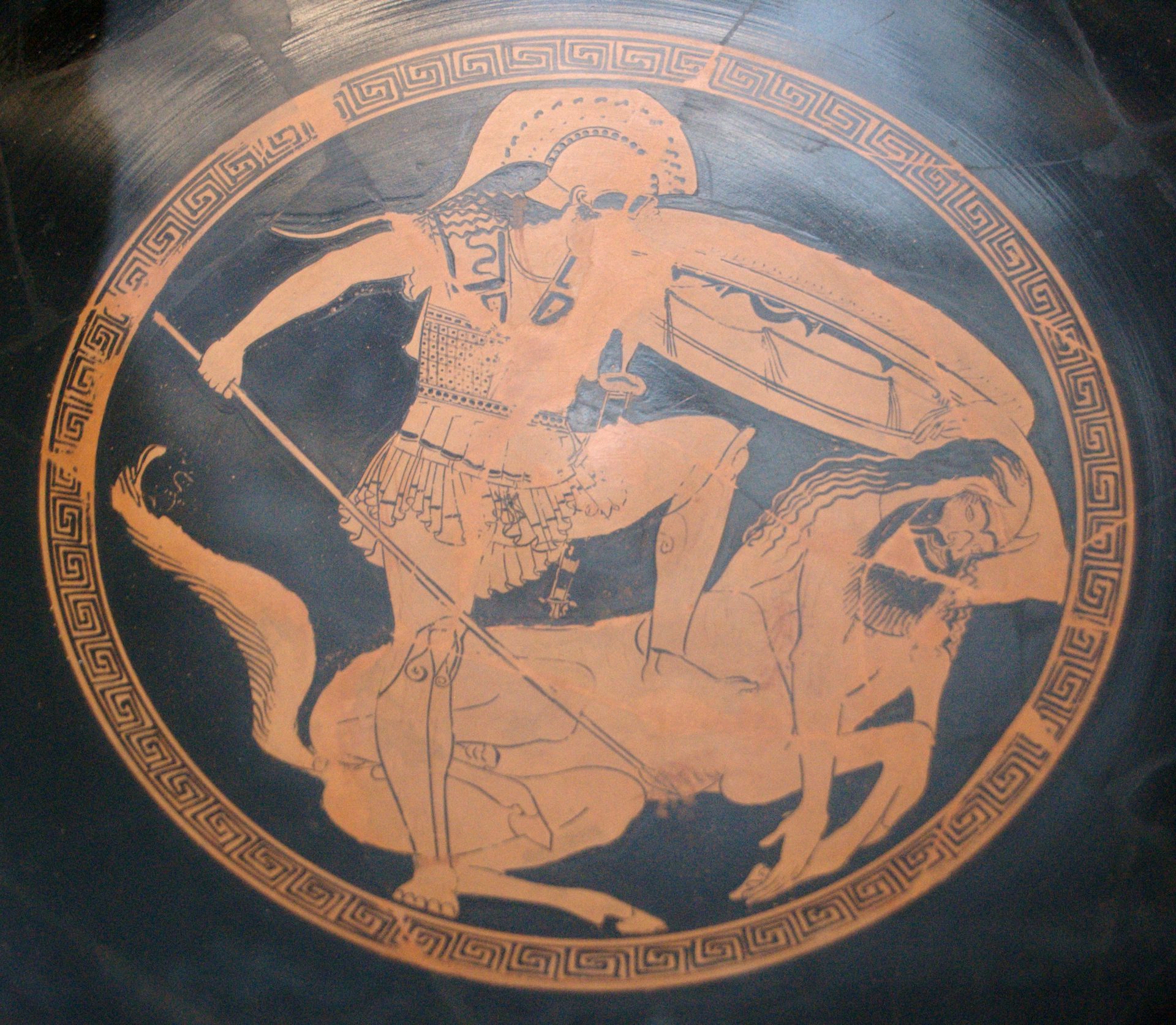
Tondo of Attic red-figure kylix showing a Centauromachy. By the Foundry Painter (ca. 480 BCE). Staatliche Antikensammlungen, Munich, Germany.
Bibi Saint-PolPublic DomainSome individual Centaurs were also represented in specific episodes from their mythology: the wise Centaur Chiron, for instance, appeared as the tutor of Achilles or the adviser of Peleus; the friendly Pholus appeared in scenes with Heracles; the brutish Nessus, known for trying to rape Heracles’ wife Deianira, was represented, too, especially in vases from the Archaic period (ca. 800–480 BCE).
The Greek iconography of the Centaurs was adopted by the Romans with very few changes. Thus, throughout Roman history we find Centaurs and Centauromachies on wall paintings, mosaics, sarcophagi, and engraved gems.[20]
Family
Family Tree
Parents
Fathers
Mothers
- Ixion
- Centaurus
- Nephele
- Magnesian Mares
Mythology
Origins
Historical
Today, it is usually assumed that the myth of the Centaurs arose when the early Greeks first encountered horseback-mounted riders. The novel sight would have been interpreted as a single creature that combined the features of man and horse, thus producing the fabulous Centaurs.
But other possibilities exist, too. The Centaurs may have originally entered Greece from Indo-European mythology or religion, in which horses and horseback riding often played an important role.[31] Or they may have been conceived as symbols of the chaos and barbarism lurking just outside of civilization (they certainly evolved into symbols of barbarism, even if they did not originate as such).[32]
Mythological
The Greeks themselves knew of several different mythical traditions about the origins of the Centaurs, just as they knew several traditions about their parentage.
The most familiar myth begins with Ixion, the king of the Lapiths of Thessaly. Ixion had fallen in love with Zeus’ queen Hera and longed to sleep with her. But Zeus discovered his intentions and substituted a cloud nymph that looked like Hera in place of the true goddess. This nymph was called Nephele (which means “Cloud” or “Cloudy” in Greek). After Ixion slept with Nephele, Zeus punished him for his attempted adultery by binding him to a rotating wheel in Tartarus.
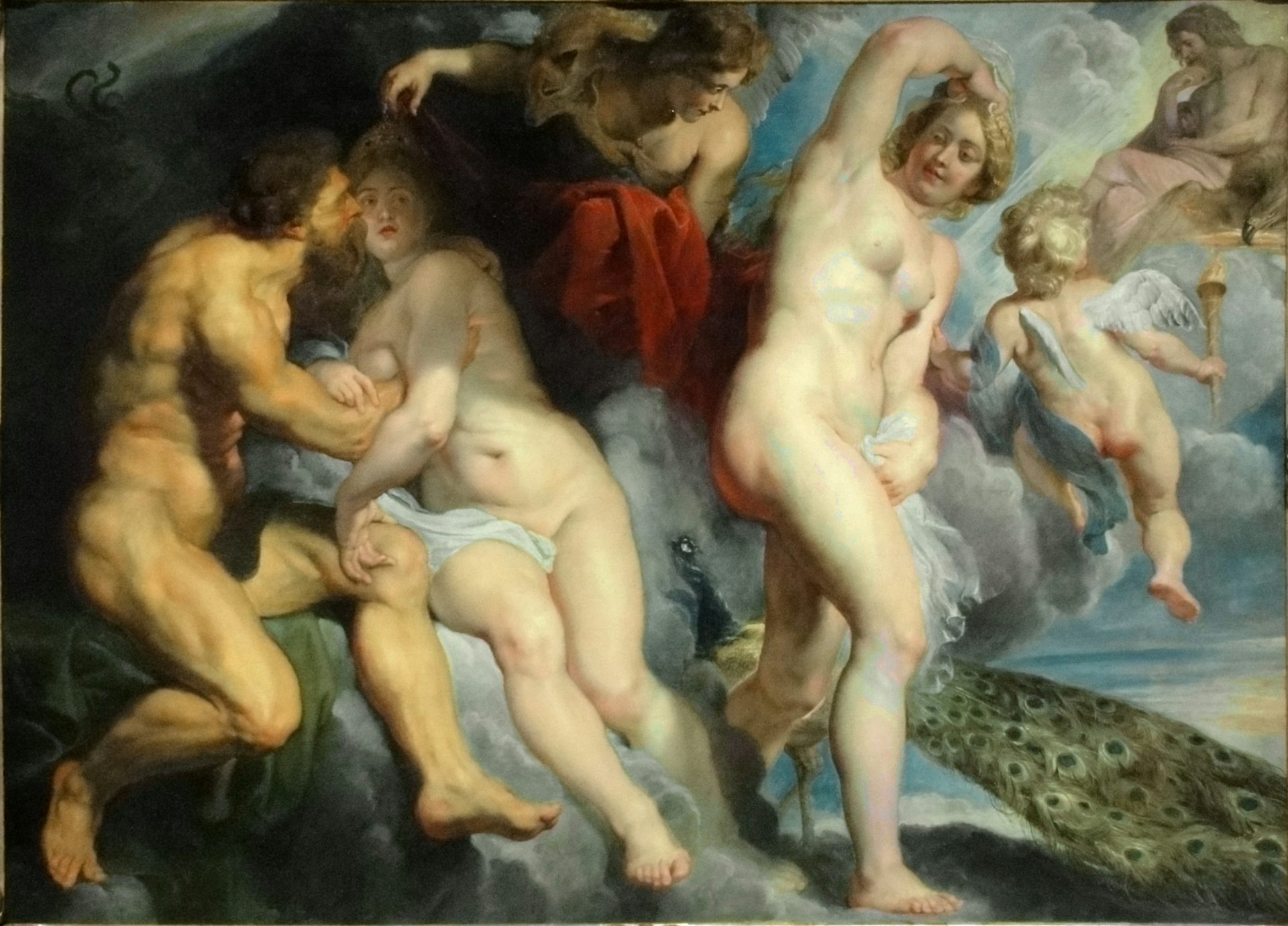
Ixion, King of the Lapiths, Deceived by Juno, Whom He Wished to Seduce (1615).
Louvre Museum, Paris FrancePublic DomainNephele, meanwhile, had been impregnated by Ixion. In one version, she had a son named Centaurus (or several children known as the Centaurs). This Centaurus, who seems to have been human in form, raped the Magnesian mares of Mount Pelion, and the mares in turn gave birth to the half-human, half-horse Centaurs.[33] In another version, the Centaurs were the offspring of Ixion and Nephele.[34]
There were several variations on this tradition. In one, the Centaurs were born when Ixion slept with his mares.[35] In another, the slave Dia slept with both Ixion and the winged horse Pegasus on the same night and subsequently gave birth to offspring that combined the features of her two lovers.[36]
Other sources claimed that there were several different kinds of Centaurs, each with separate origins.
According to Nonnus, there were two types of Centaurs (in addition to the familiar kind). One was born to the Naiad daughters of the River Lamus. These Naiads had made the mistake of nursing Zeus’ bastard son Dionysus, thus incurring the wrath of Zeus’ wife Hera. Hera transformed the daughters of Lamus into creatures with cow horns, shaggy hair, and tails (a kind of cross between a Centaur and a satyr or silen). Their offspring ended up with the same shape.[37]
The other race of Centaurs was connected with the island of Cyprus. These Centaurs (also horned) were born when Zeus tried to have sex with Aphrodite; the goddess fled from him, and he ejaculated on the ground of Cyprus instead.[38] The Centaurs sprang up from the spot where his seed had spilled.
There were some creatures in Greek mythology who were known as Centaurs but whose origins were completely different. Chiron, for example, was the son of Cronus and Philyra, while Pholus was the son of Silenus and one of the Meliae. It is probably no coincidence that Chiron and Pholus, who were not related to the other Centaurs, were also the only “good” Centaurs.
Other Explanations
Even in antiquity, there were attempts to come up with rational explanations for the Centaurs, but these tended to be far-fetched. One writer, Palaephatus, suggested that Centaurs were simply mounted archers from a village called Nephele who helped their neighbor Ixion rid his kingdom of a herd of wild bulls that were ravaging it (hence their name, which in Greek can be interpreted as “bull-pokers”).[39]
Much later, the twelfth-century Byzantine scholar-poet John Tzetzes told another rationalized version of the Centaurs’ origins. Tzetzes claimed that Ixion had slept with one of Hera’s servants, and that she gave birth to a son named Imbrus whose nickname was “Centaur.” He, in turn, became a horse farmer and had sons—the “Centaurs”—who were famous for their horseback riding skills.[40]
Centaurs and Heroes: Centauromachy
The mythology of the Centaurs generally revolved around “Centauromachies”—battles with the great Greek heroes. The most important Centauromachy was between the Centaurs and the Lapiths, but there was also a well-known encounter between the Centaurs and Heracles.
The Centaurs and the Lapiths
The Lapiths were a people who lived in the northern Greek region of Thessaly. Ixion, the father or grandfather of the Centaurs, had once been their king and was eventually succeeded by his human son Pirithous. The Centaurs and Lapiths were thus closely related.
Early accounts of the battle between the Centaurs and the Lapiths did not give any clear cause for the violence. Given the shared ancestry of the two sides, a quarrel over inheritance may have been involved.[41] Some later traditions made Ares the instigator.[42] But in the most complete account of the battle, known from Ovid’s Metamorphoses, violence erupted when the Centaurs, who had come to the wedding of Pirithous, attempted to carry off the women—even the bride.
It all began civilly enough. Pirithous, the king of the Lapiths, was marrying Hippodamia (though her name differs in some accounts), and many of his subjects—including the Centaurs—had come to attend the wedding. But at the feast, the Centaurs became drunk and began assaulting the women. One of the Centaurs, Euryton (or Eurytus), even tried to carry off Pirithous’ bride.
A bloody brawl soon broke out between the Centaurs and the human heroes at the feast. Ovid describes the scene in extravagant, gory detail:
[the Centaurs] all shouted out,
“To arms! to arms!” Their courage raised by wine!
In their first onset, hurled cups flew about,
and shattered wine casks, hollow basins—things
before adapted to a banquet, now
for death and carnage in the furious fight.[43]
Amidst the carnage, Pirithous and his close friend, the Athenian king Theseus, slew many Centaurs. But the Lapiths also lost some of their own. Caeneus, a Lapith hero, was killed by the Centaurs, who buried him beneath a mountain of uprooted trees when they realized he was invulnerable to weapons.
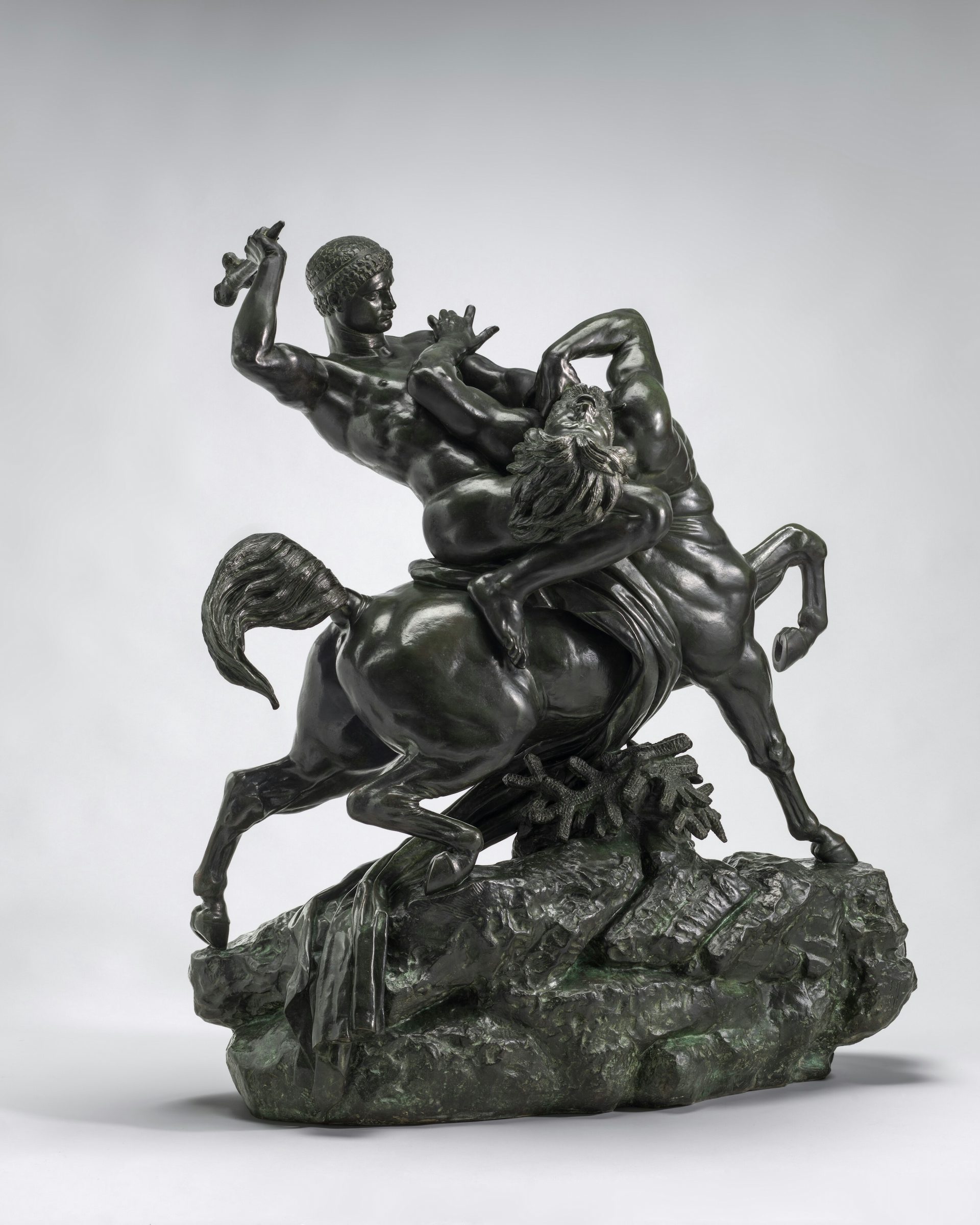
Theseus Fighting the Centaur Bienor by Antoine-Louis Barye (model 1849, cast 1873).
National Gallery of Art, Washinton DCPublic DomainIn the end, the Lapiths defeated the Centaurs. This battle, it was said, became the cause of all later battles between Centaurs and humans. The Centaurs who were not killed were driven away.[44]
The Centaurs and Heracles
Another tale told of how the Centaurs battled Heracles—another fight that did not go their way. Heracles was passing through Arcadia on his way to catch the Erymanthian Boar (one of his Twelve Labors). Some Centaurs, it was said, had settled in this region after their defeat at the hands of Pirithous and the Lapiths.
Heracles was staying with his friend Pholus, one of the rare civilized Centaurs. Despite Pholus’ warnings, Heracles insisted on opening a jug of wine. The scent of the alcohol drove the Centaurs into a frenzy, and they attacked Heracles.
In the ensuing battle, Heracles killed many Centaurs—including, by accident, the two good Centaurs, Chiron and Pholus. One of Heracles’ arrows, poisoned with the Hydra’s blood, had passed through the arm of an attacking Centaur to strike Chiron. Though Chiron was immortal, the poison from the arrow caused him unending anguish. The gods eventually took pity on him and allowed him to die.
Pholus, wondering how such a small arrow could bring down a fellow as big as Chiron, pricked his finger as he was inspecting the weapon and dropped dead, also succumbing to the Hydra’s poison.
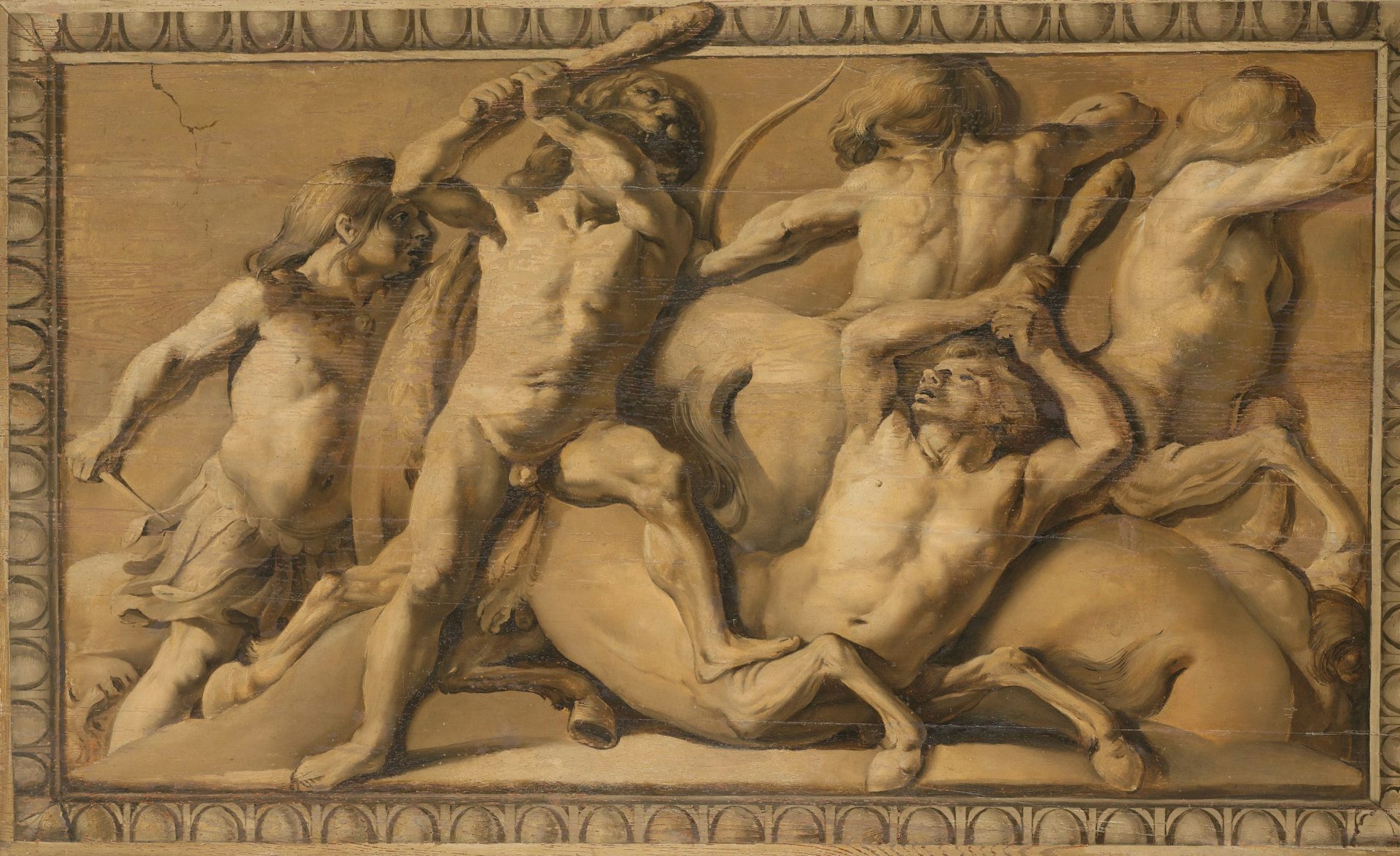
Hercules Defeating the Centaurs by Jacon van Campen (ca. 1645–1650).
Rijksmuseum, Amsterdam, NetherlandsPublic DomainThe few survivors fled to other parts of Greece, with some moving further south to Cape Malea, some northeast to Eleusis, and others northwest to the Evenus River.[45]
Other Battles
The Centaurs’ violent and lecherous tendencies brought them into conflict with other heroes (and heroines) as well.
In one myth, the lust-crazed Centaurs Rhoecus and Hylaeus came across the heroine Atalanta while she was hunting and tried to assault her. Atalanta, of course, was not quite the demure and passive maiden the Centaurs were expecting. She defended herself and slew Rhoecus and Hylaeus without much difficulty.[46]
In another myth, the Centaurs went up against the hero Peleus, the father of Achilles. It began when the wife of the Phthian king Acastus tried to seduce Peleus. The noble Peleus, however, would not succumb to her advances. Angry and bitter, Acastus’ wife told her husband that Peleus had attempted to seduce her.
In a misguided attempt to take revenge on Peleus, Acastus lured him into the woods. He then stole Peleus’ sword and left him to be killed by the Centaurs. But the good Centaur Chiron found the sword and returned it to Peleus, allowing him to defend himself successfully against the fearsome Centaur horde.[47]
Another myth told of how one Centaur, Nessus, unwisely provoked Heracles for a second time (see above). Heracles had just married the Calydonian princess Deianira and was traveling with her to his home. During their journey, the couple needed to cross the Evenus River. Nessus, who lived nearby, offered to ferry Deianira across (the famously strong Heracles was apparently happy to simply swim across).
In the middle of the crossing, however, Nessus tried to rape Deianira. Heracles responded by shooting Nessus with one of his poisoned arrows. But Nessus ultimately had his revenge: as he was dying, he urged Deianira to keep a vial of his blood. He told her that this blood would serve as a love charm if she ever feared that Heracles’ affections were waning.
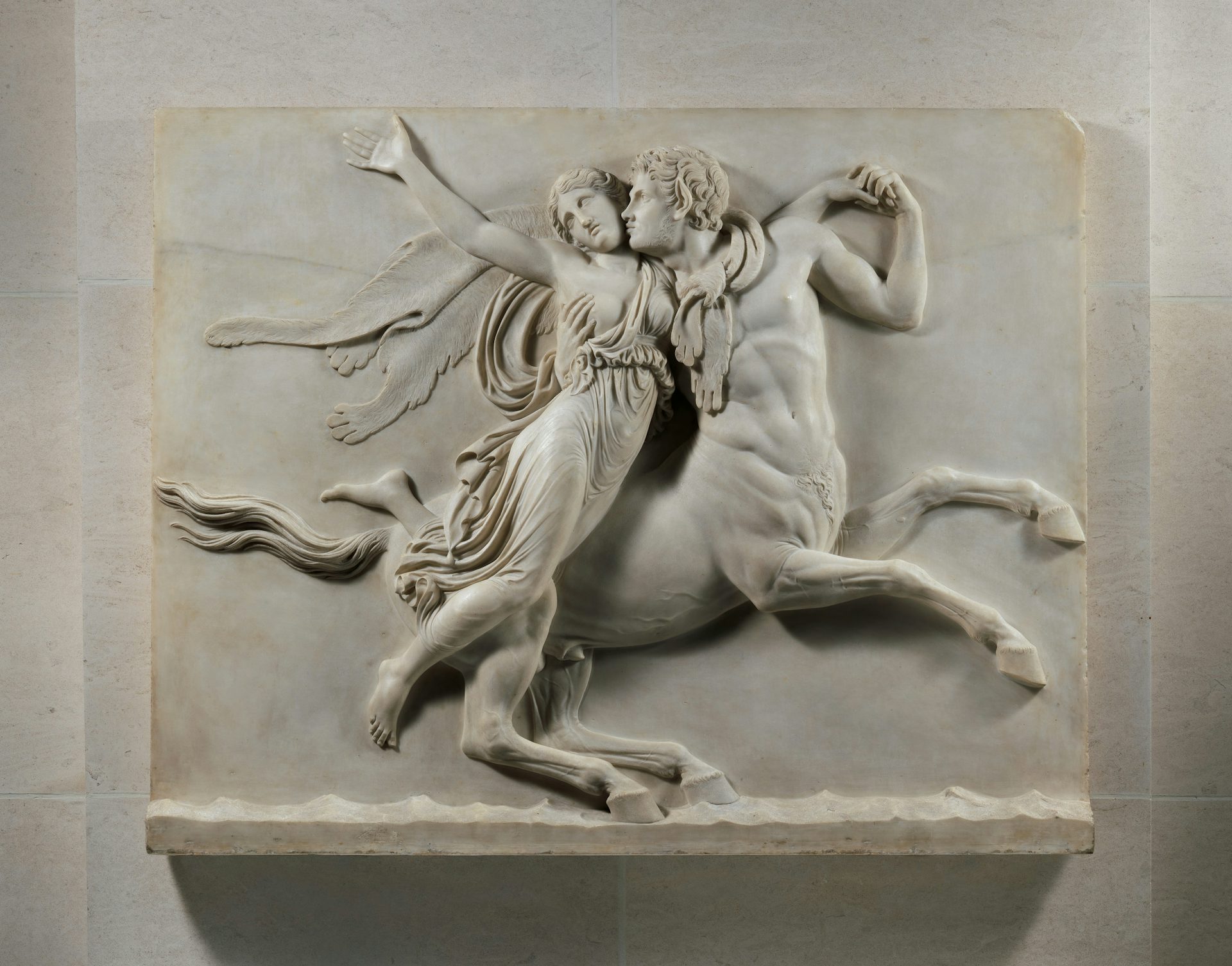
Nessus Abducting Deianira by Bertel Thorvaldsen (modeled 1814–15, carved 1821–23 or 1826).
Metropolitan Museum of ArtPublic DomainOf course, Nessus was lying: he knew that Heracles’ arrow, tipped with the Hydra’s poison, had infected his blood, and that it would destroy Heracles if Deianira ever followed his advice. Sure enough, when several years had passed and Deianira suspected that Heracles had fallen in love with another woman, she smeared some of the Centaur’s poisoned blood on Heracles’ clothing, inadvertently killing her husband.[48]
The Wisdom of the Centaurs
Though most Centaurs were savage, violent, and lawless, there were two “good” Centaurs. One, Pholus, was a friend of Heracles. The more important one, however, was Chiron—probably the most famous of all the Centaurs.
Chiron, unlike the other Centaurs, was not a descendant of the sinful Ixion. Rather, he was the son of Cronus, the powerful Titan who had ruled the cosmos before the Olympians, and Philyra.
Also unlike the other Centaurs, Chiron was a wise, gentle, and helpful creature, described by Homer as “the most righteous of the Centaurs.”[49] Chiron was extremely knowledgeable in the art of warfare but also in the arts of healing and even music. From his mountain home, he trained some of the greatest heroes of Greek mythology, including Jason, Asclepius, and Achilles.
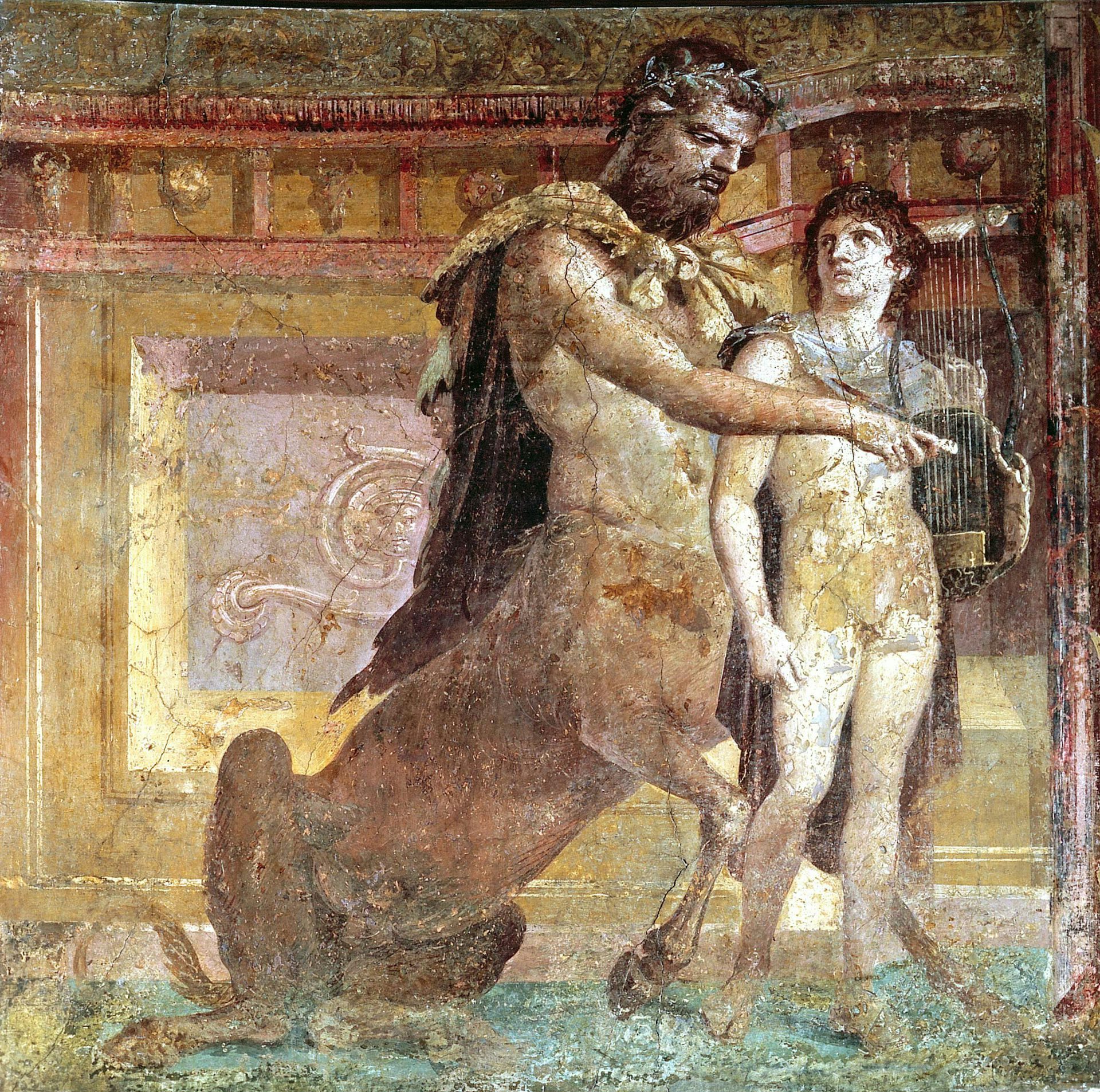
Roman fresco showing the Centaur Chiron teaching Achilles to play the lyre. From Herculaneum (first century CE).
National Archeological Museum, Naples, ItalyPublic DomainWhen Heracles accidentally shot Chiron with one of his poisoned arrows (see above), the Centaur suffered terribly: he was immortal and therefore could not be put out of his misery. Eventually, he was able to give up his immortality, possibly in exchange for the end of Prometheus’ eternal punishment.[50]
Pop Culture
Centaurs remain extremely popular to this day. They are frequently found in adaptations of Greek mythology and are even more prevalent in the fantasy genre.
Centaurs are still usually represented as wild and uncivilized. In J. K. Rowling’s Harry Potter, they do have some productive skills, but are mostly barbarous; in Rick Riordan’s Percy Jackson and the Olympians series, they are reckless “party animals,” with the exception, of course, of the wise Chiron.
But some authors have reimagined the Centaurs as civilized and capable creatures. In C. S. Lewis’ The Chronicles of Narnia, for example, the Centaurs are highly skilled in various arts, including warfare, healing, and prophecy. Similarly, in the TV show Xena: Warrior Princess, the Centaurs are generally reliable and helpful allies of Xena.
Others have taken a different approach, offering a rationalized interpretation of the Centaurs as human herdsmen and horsemen living a semi-nomadic lifestyle in the mountainous regions of the Greek world. This approach can be seen in Mary Renault’s The Bull from the Sea, the second of Renault’s two novels on the myth of Theseus. Here, the rationalized “Centaurs” retain their familiar barbarous traits; only their leader, “Old Handy” (a calque of the Greek name “Chiron”), is restrained and diplomatic, trying to make peace with the Lapiths.
Centaurs are also popular among the fantasy creatures of today’s video and role playing games. They feature, for example, in Dungeons and Dragons, Warcraft, and Age of Mythology. By and large, they are represented as they were in the ancient Greek world, as men above and horses below.
Finally, May 14 is embraced by some individuals on social media as “International Centaur Appreciation Day.”